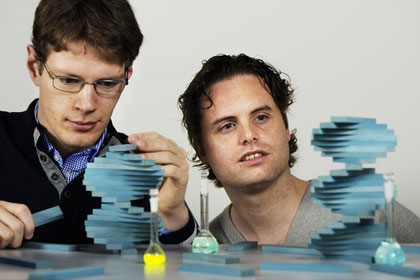| Oct 10, 2013 |
New model gives better control of self-assembly processes
|
|
(Nanowerk News) Researchers at ICMS (Institute for Complex Molecular Systems) have developed a new model that allows better control of self-assembly, the process through which molecules aggregate by themselves into larger clusters. This model could be used in the production of plastic solar cells, and is an interesting step in the long-term process of developing a synthetic cell. The research was published online in the journal PNAS ("Model-driven optimization of multicomponent self-assembly processes").
|
 |
| Researchers Peter Korevaar (left) and Tom de Greef. Photo: Bart van Overbeeke.
|
|
Molecular self-assembly is often a matter of trial and error: the basic molecules are brought together and then you just – more or less – have to wait and see if the result has the desired structure. In their publication the Eindhoven University of Technology (TU/e) researchers, supervised by prof.dr. Bert Meijer, describe a model that allows better control of the assembly process. Which means the model provides a kind of guide to which parameters need to be changed (for example the temperature, concentration and solvent used) to ensure the right material is assembled.
|
|
Plastic solar cells
|
|
In this publication the authors show how their model works in an assembly process of two molecules, which together form a material similar to that used for plastic solar cell. The model could find practical application in the near future to optimize the production process for these solar cells, as well as for other biomaterials such as hydrogels.
|
|
Synthetic cell
|
|
This is the first time that a model-based approach has been used to control a self-assembly process. According to lead author ir. Peter Korevaar, the added value results from a better understanding of the interactions between the molecules on which the model is based. This will allow extension to more complex assembly processes, as well as the prediction of their outcomes, with the building of a synthetic cell as the longer-term goal.
|

